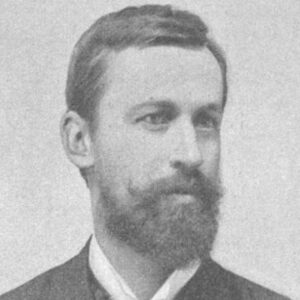Max Fabiani was a late-nineteenth- and early-twentieth-century Italian-Austrian-Slovenian architect. He is best known for his contributions to the Viennese ‘Secession’ style, which he, along with architects Ivan Vancas and Ciril Metod Koch, helped introduce to Slovenia. Born into a cosmopolitan, trilingual family, he applied his architectural talents throughout the former Austrian Empire, contributing to the Viennese cityscape as well as the architecture of cities and towns that would eventually become part of Slovenia and Italy. Given his working years, several of Fabiani’s commissions coincided with the need to rebuild cities following World Wars I and II. He also created memorials for fallen soldiers. Apart from his work as an architect, Fabiani made a brief foray into politics. In the 1940s, he was elected mayor of Staniel, his hometown. As a result of his position and fluency in German, he was able to prevent his village from being occupied and destroyed during the war. Fabiani has been widely credited with popularizing the Vienna Secession style, particularly in Slovenian architecture. He also held several academic positions, including that of professor at Vienna’s Technische Hochschule. Later in life, he taught art history at a Gorizia high school.
Childhood & Adolescence
Fabiani was born in Kobdil bei Staniel on 29 April 1865, which was then part of the Austro-Hungarian Empire and is now part of modern-day Slovenia.
He was born into a prosperous and cosmopolitan family; his father was a Friulian latifundist with Bergamesque ancestors, and his mother was a Triestine aristocrat with Tyrolean ancestors.
As a child, he spoke Italian at home, Slovene with his peers, and German at school. He attended elementary school in Kobdilj with his 13 siblings and then Realschule, a type of secondary school in Ljubljana.
Career of Max
He relocated to Vienna in order to earn a degree in architecture from the Vienna University of Technology, which he completed in 1889.
Between 1892 and 1894, he used a scholarship to spend nearly three years traveling throughout Europe and Asia Minor, including stays in Greece, Italy, Germany, France, Belgium, and England.
He returned to Vienna following his travels and joined the studio of architect Otto Wagner, where he remained until 1900.
He was commissioned to provide urban planning for Ljubljana following the city’s 1895 earthquake, a bid he won due to his familiarity with the city and his modern designs.
He was commissioned in 1903 and 1904 to design the national halls in Gorizia and Trieste, largely based on his designs for Ljubljana.
Between 1910 and 1917, he worked at the Technical University of Vienna as a professor of ornament and interior decoration.
He was appointed professor at the University of Vienna in 1917, a position he retained despite an offer to teach at the University of Ljubjlana.
In the 1920s, he was instrumental in a reconstruction project that rebuilt monuments in areas of Italy devastated by the First World War, primarily along the Julian March’s length. Between 1924 and 1927, he taught art history at a high school in Gorizia.
He was appointed mayor of Stanjel by the National Fascist Party in 1935, a position he held throughout the Second World War, during which he played a critical role in preventing the town’s destruction.
Fabiani worked as an inspector for the Italian cultural heritage foundation between 1938 and 1962, determining which buildings and monuments deserved funding for preservation or rehabilitation. Fabiani returned to Gorizia in 1944 and remained there for the remainder of his years.
Significant Works of Max
He completed the Mladika Palace in Ljubljana in 1907, one of the most acclaimed architectural elements of his 1907 urban planning for the city.
In 1900, he designed the Palace Artaria, one of Vienna’s most recognizable structures, which is still in use as a publishing house today.
He designed the Palace Urania in Vienna in 1902, a landmark of the Vienna Ring Road that serves as a public educational institute and observatory today, following extensive reconstruction following World War II.
In 1904, he designed the National Hall in Trieste, one of a number of civic and governmental buildings he designed.
He was in charge of the general urban development plan for Monfalcone, Italy, in 1919.
In 1937, he designed the ‘Tower of Memory,’ a memorial to Italian soldiers killed in the First World War that was erected in Gorizia, Italy, where he spent his final years.
Awards and Accomplishments
In 1915, he was awarded the Vienna Community’s Prize for Exceptional Construction for his work on the Geschaftshaus in Vienna’s sixth district.
He was knighted of the Red Eagle Order (‘Ritter des Roten-Adler-Ordens’) in 1917. He received the Italian Order of Merit for Culture and Art on 10 September 1951.
He was awarded a ‘Golden Doctorate’ by the Vienna University of Technology at the age of 80. He also received knighthoods and honorary degrees from a variety of orders, including the Franz-Josefs-Orden, the Ehrenlegion, and the Vatikanischen Verdienst-Ordens.
Personal History and Legacies
He was previously married to Francesca di Rochi, but the couple divorced. They had two children together, Carlotta and Lorenzo. Lorenzo went on to establish a successful career as an agronomist and journalist. He died in Gorizia, northern Italy, on August 18, 1962.
Since 2008, the highest Slovenian award for urban planning excellence has been named after his illustrious architect.
Estimated Net Worth
Max is one of the wealthiest architects and is listed on the list of the most popular architects. Max Fabiani’s net worth is estimated to be between $1-5 million, based on our analysis of Wikipedia, Forbes, and Business Insider.
Trivia
A widely circulated but implausible legend about Fabiani is that a young Adolf Hitler briefly worked in his Vienna architecture firm.
The street Fabianistrasse in Vienna’s Simmering District was named in 1984 as a tribute to Fabiani. Numerous streets in Ljubljana and Gorizia bear his name.


